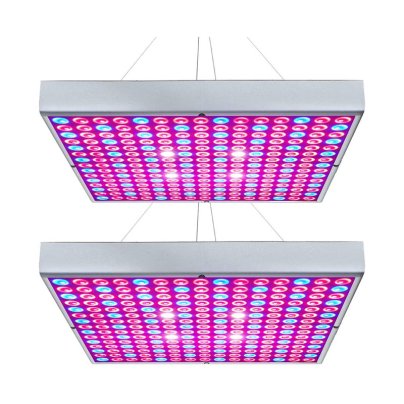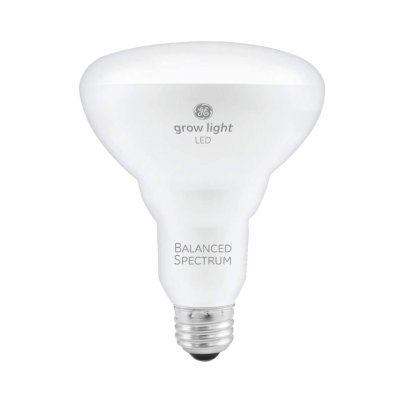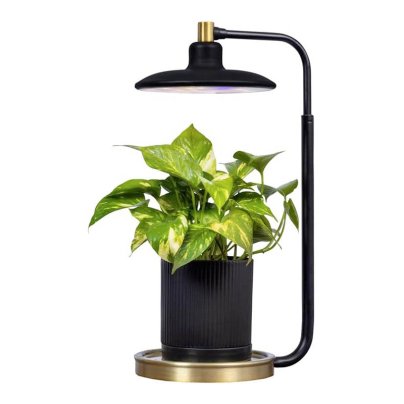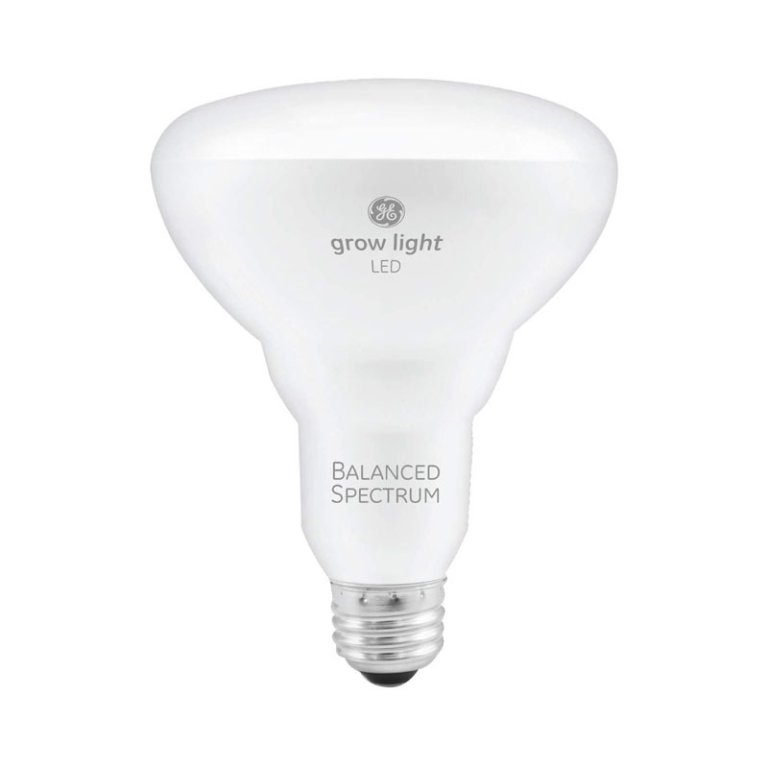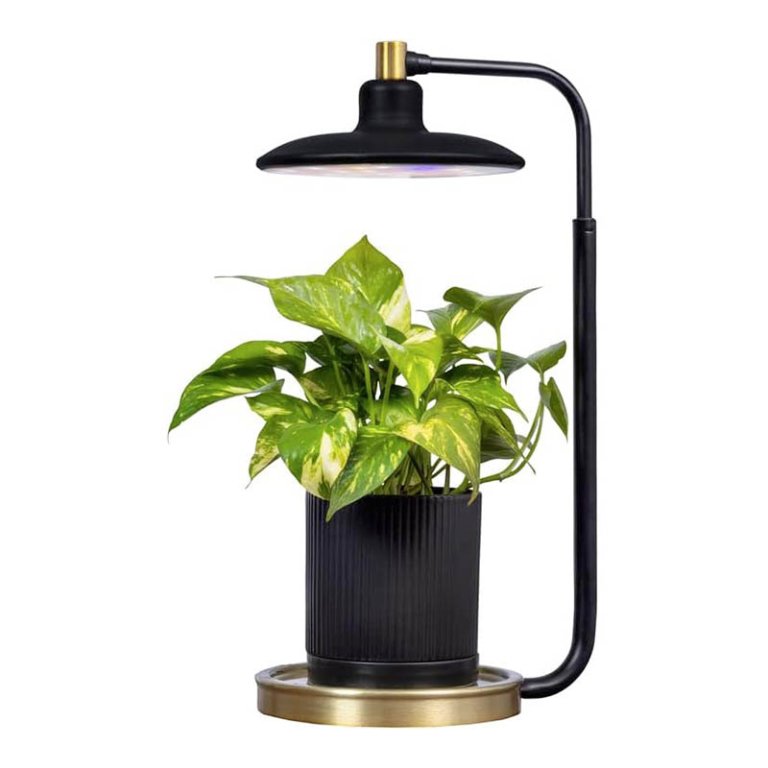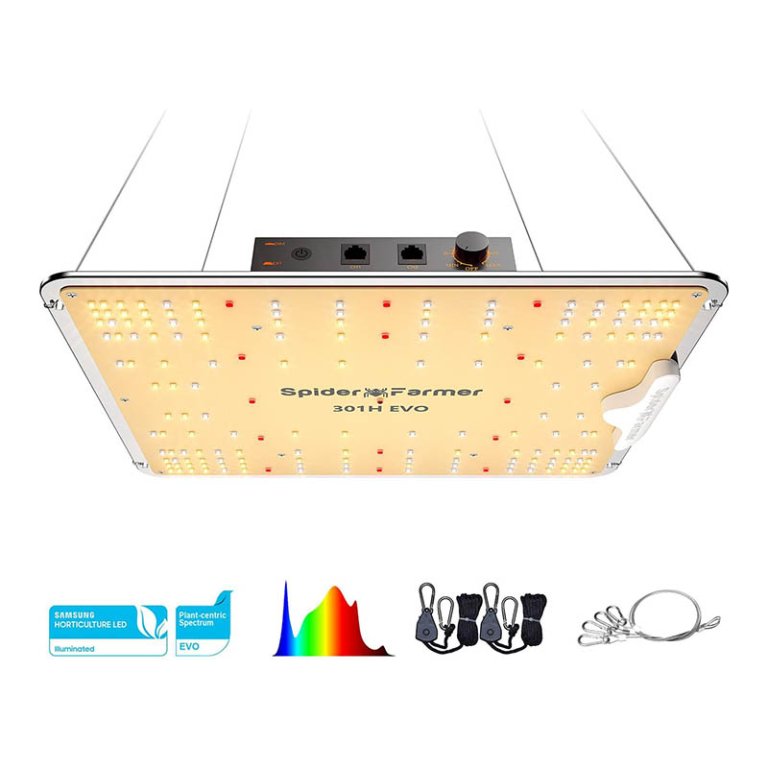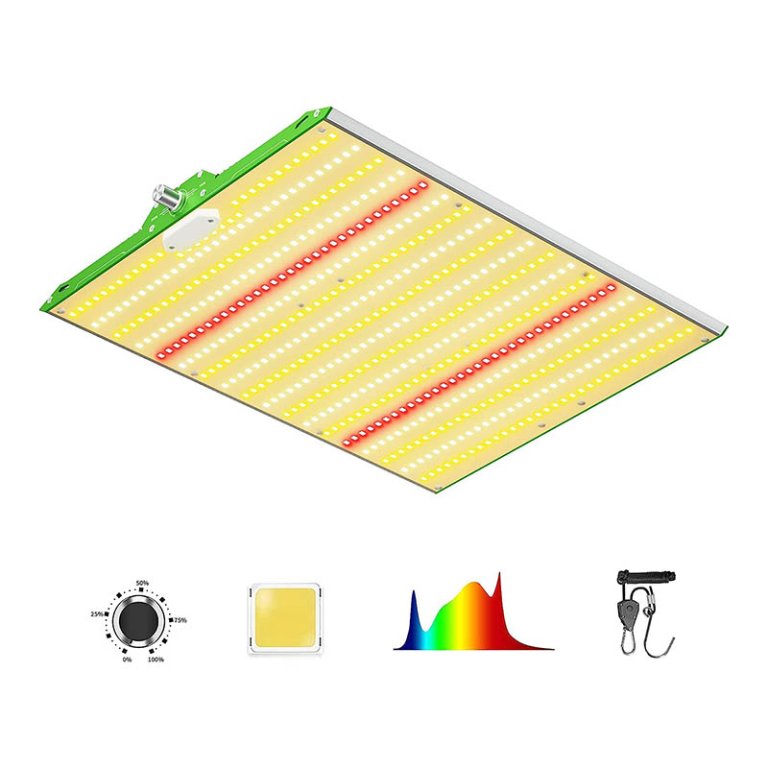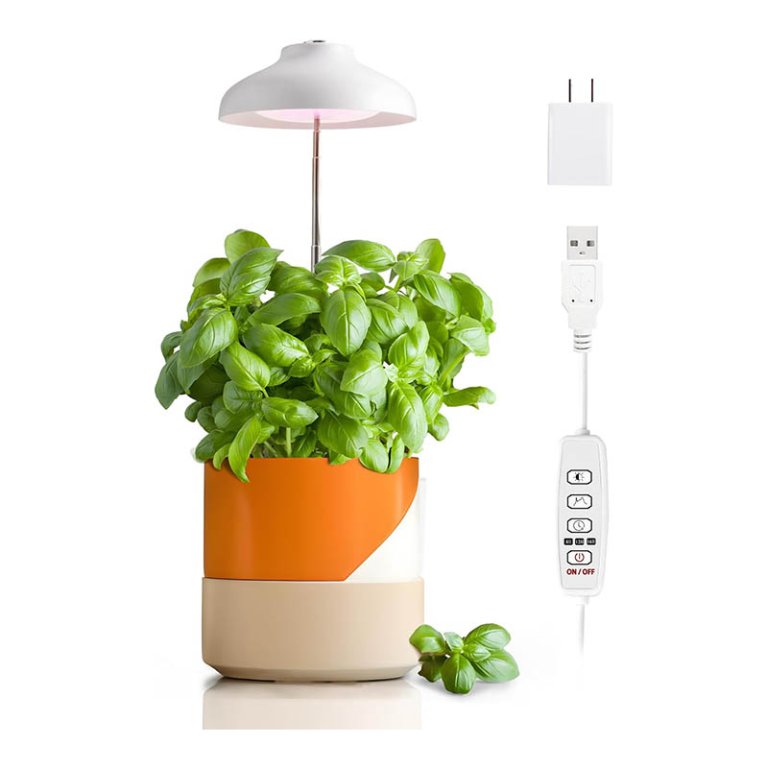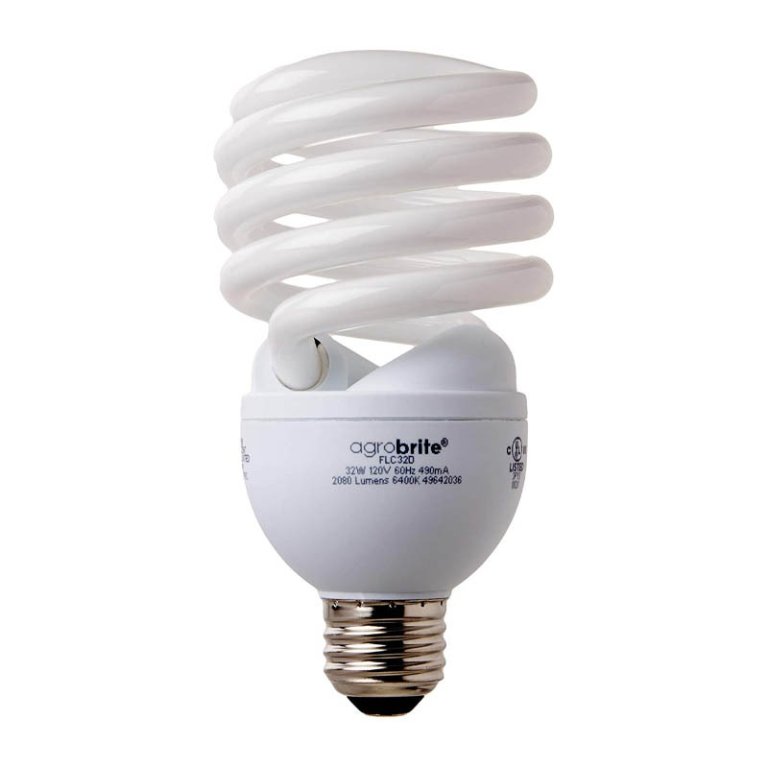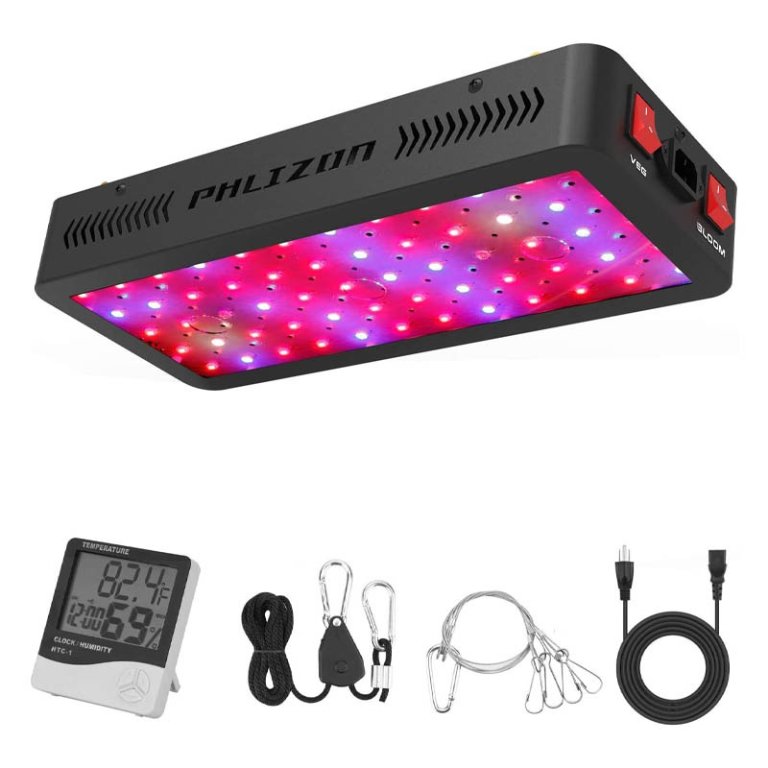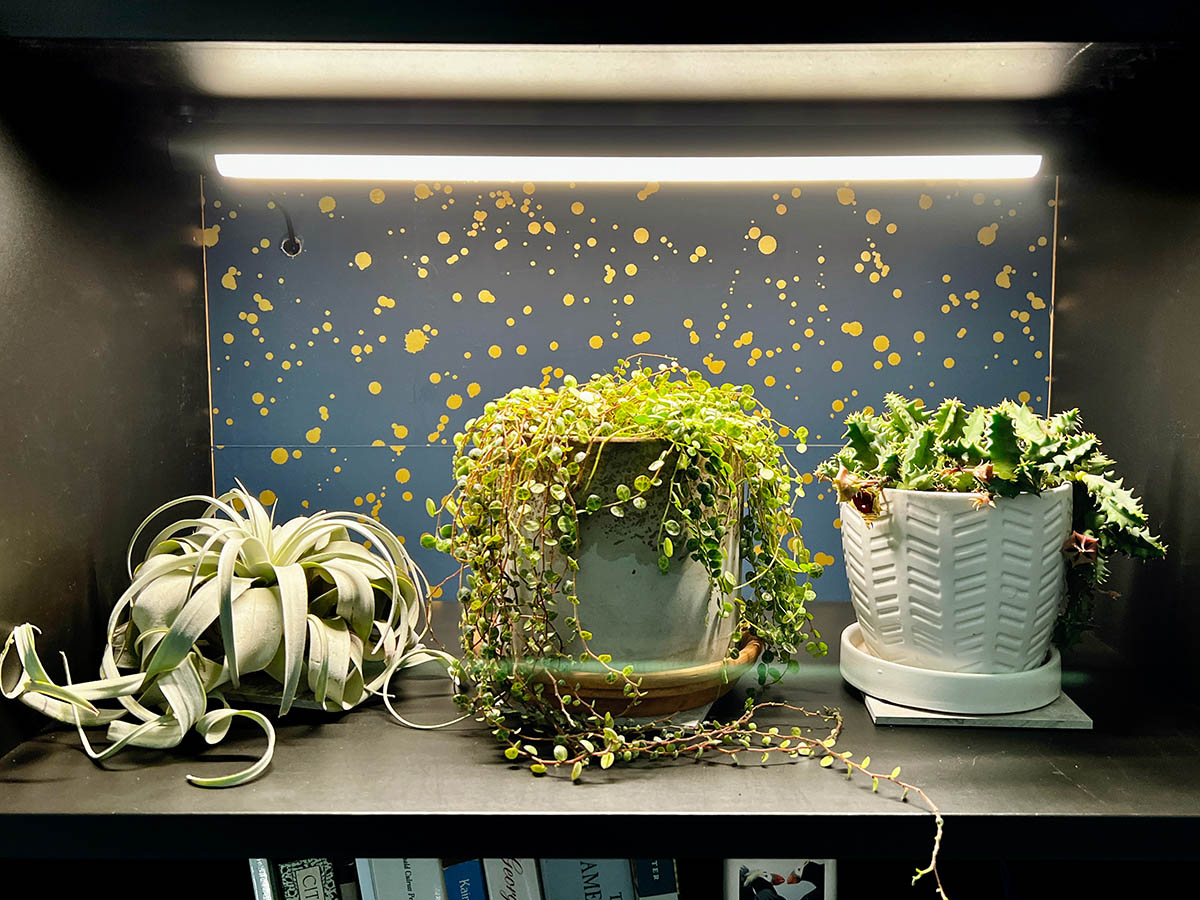
We may earn revenue from the products available on this page and participate in affiliate programs. Learn More ›
When it comes to plants, all light is not equal. Unless you have a greenhouse or unlimited south-facing windows, grow lights are your best option for providing your plant with the right level of illumination. Though nothing is better than natural sunlight, grow lights are designed to provide photosynthetic active radiation (PAR) so the plant can undergo photosynthesis like outside in nature. We wanted to know if they worked well enough to keep plants alive—and thriving—so we tested the most popular models on the market.
We placed the grow lights in areas that were otherwise too dark for plants to grow, and we tried them out on various indoor plants, from houseplants and herbs to flowering seedlings. We kept track of plant health, overall growth, and the development of new leaves. Learn what to look for when selecting the best grow lights for your indoor plants, and discover the pros and cons of the following models before choosing.
- BEST OVERALL: Hytekgro LED Grow Light Panel
- BEST BANG FOR THE BUCK: GE Grow LED Light Bulb for Seeds and Greens
- BEST FOR HOUSEPLANTS: AeroGarden Tabletop Grow Light
- BEST EXPANDABLE: Spider Farmer SF-1000 LED Grow Light
- BEST TABLETOP: LBW Full Spectrum 150W LED Grow Light With Stand
- BEST ADJUSTABLE: Bestva Dimmable Pro Series LED Grow Light
- BEST FOR SMALL POT: GrowLED LED Umbrella Grow Light
- MOST VERSATILE: Hydrofarm Agrobrite Compact Fluorescent Grow Lamp
- BEST MONITORING: Phlizon 600W Full Spectrum LED Grow Light
- BEST FOR SHELVES: Soltech Grove LED Grow Light
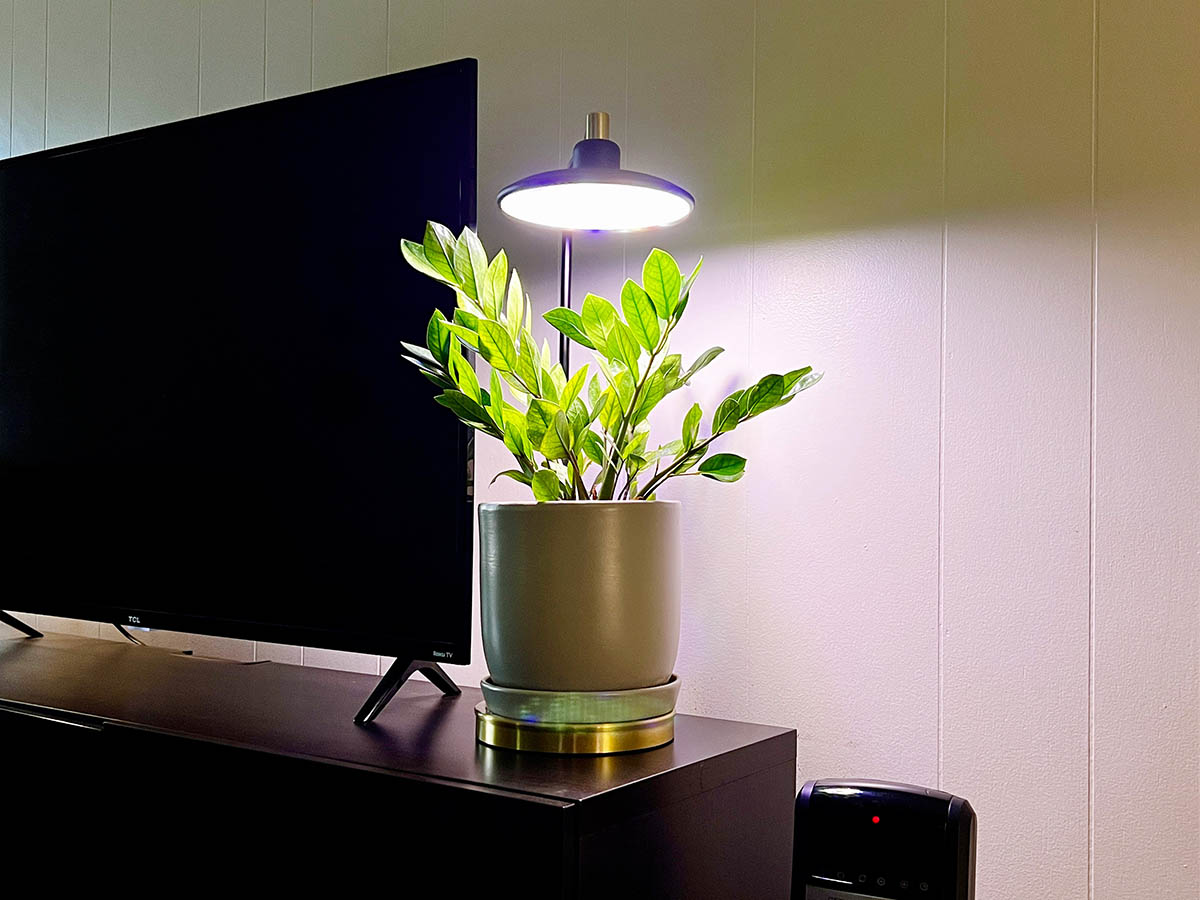
How We Tested the Best Grow Lights
After reading information about the benefits of grow lights, we wanted to determine whether the hype was true. While we’re not professional growers by a long shot, we enjoy starting seeds, and we have several houseplants that always seem a bit undernourished due to inadequate light.
We tried to keep the testing as scientific as possible by providing the recommended amount of light—by plant type—with the grow lights. To determine each light’s practical coverage, we darkened the room, turned on the grow light, and measured the distance of the brightest part of the light pattern.
We tested timers on the lights that came with them to see how accurate they were, and we frequently tested for heat generation by putting our hands beneath the grow lights to see if they were producing heat. We recorded our observations and awarded points based on a rubric throughout the testing.
We observed the plants and noted any significant changes, but it’s important to remember that this was subjective since we used different plants, including seedlings, houseplants, and overwintered patio plants. In addition, they were all in various states of health when we began the testing.
We selected the grow lights for testing based on the manufacturer’s reputation. Still, we didn’t automatically eliminate lights made by smaller manufacturers as long as they provided ample light and were well made.
After the tests, we added the accumulated points and used them to create the best category for the individual grow lights. While each has a specific purpose, any model in our lineup will benefit various growing situations.
Testing Stats
- Products tested: 10
- Time spent testing: 6 weeks
- Tests performed: 4
- Average price: $55.93
Our Top Picks
To qualify for a spot in this lineup of the best grow lights, the following models had to perform well in our hands-on tests. We paired each light with various plants or germinating seeds and tested each function on the lights, including timers, dimmers, and temperature monitors. Overall, grow lights are relatively straightforward tools, offering added illumination without creating heat. The following grow lights performed well in our tests, although each is designed for a slightly different growing situation.
Best Overall
Hytekgro LED Grow Light Panel
Pros
- Easy to hang due to lightweight construction
- Provides low heat settings to prevent plant burn or overheating
- Emits bright light, supporting the growth of multiple plant varieties
Cons
- Lacks an included timer, which may not meet some users’ preferences
Product Specs
- Size: 12 inches long by 12 inches wide
- Light color: Red, blue, and white
- Estimated coverage area: 3 feet long by 3 feet wide (per panel)
Our Ratings: Setup 5/5; Adjustability 3/5; Durability 4/5; Coverage 4/5; Value 4/5
Lightweight and easy to install, the Hytekgro LED light panel puts out a full spectrum of color to support all stages of plant growth. The two-panel kit includes steel hanging brackets for proper height adjustment. Each 12-inch-long by 12-inch-wide panel distributes light across approximately 3 square feet when suspended 18 inches from the top of a seedling tray. The light emitted has a purple glow, which may be something to consider if it will light up plants in a living space.
We hung the Hytekgro lights over flowering seedlings we purchased for transplanting in the garden, and we turned the panels on for 16 hours daily. The seedlings didn’t grow in height too much during the weeks we tested the lights, but they did fill out, and more blooms appeared.
We watered the seedlings during the testing phase but didn’t fertilize them, so the bulk of any growth could be attributed to the lights. A real upside to the Hytekgro lights is that they didn’t heat the space, but a slight downside is that they didn’t come with a timer, so we had to set an alarm and manually turn them on and off. The square shape makes them suitable for hanging over square and rectangular flats of seedlings, and we felt the plants’ health improved during their time under the lights.
Get the Hytekgro grow light at Amazon.
Best Bang for the Buck
GE Grow LED Light Bulb for Seeds and Greens
Pros
- Emits very bright light; adequate for bedrooms, living spaces, and more
- Can emit cool light across a 2-foot diameter, offering wide coverage if desired
- Represents an affordable alternative to similar grow lights
Cons
- Offers less versatility than some alternatives, lacking an integrated fixture and timer
Product Specs
- Size: 6 inches high by 4 inches in diameter
- Light color: Red, blue, and white
- Estimated coverage area: 2-foot radius at 18 inches above plant specimen
Our Ratings: Setup 5/5; Adjustability 5/5; Durability 4/5; Coverage 4/5; Value 5/5
For those wanting to take advantage of a grow light without investing a lot of money in an elaborate system, consider the GE Grow LED bulb. It offers a range of red, white, and blue light, although it appears pure white to the naked eye, which makes it well suited for use in a living room, bedroom, or any spot in the house where plant-positive light is desired. Best of all, you can use an existing lamp or light fixture.
We used the GE LED light bulb in an aluminum work light fixture and tied it to a rack over pots where we’d planted lemon balm seeds. Like other vegetable and herb seeds, lemon balm seeds need ample light to germinate. The seeds sprouted in about 10 days, so they got enough light.
Our light fixture was crude, and when hung approximately 18 inches over the soil, the light radiated in a circular pattern about 2 feet in diameter. However, it was very bright and difficult to look at directly. We decided it could be put to better use in an adjustable-arm lamp that could be pointed toward a plant but away from eyes.
Get the GE grow light at Amazon or Walmart.
Best for Houseplants
AeroGarden Tabletop Grow Light
Pros
- Lamp-style design is attractive and functional, making it suitable for various interior decors
- Easy to program lighting time and intensity with the help of the AeroGarden app
- Can accommodate plants up to 15 inches tall, encompassing a wide range of vegetation
Cons
- Best for plants that grow upright; trailing plants may not receive enough light
Product Specs
- Size: 19 to 25 inches high by 8 inches wide
- Light color: Full-spectrum, white, warm, and cool
- Estimated coverage area: 15 inches
Our Ratings: Setup 5/5; Adjustability 5/5; Durability 5/5; Coverage 5/5; Value 4/5
AeroGarden is well known for its tabletop hydroponic systems. It comes as no surprise that it makes excellent grow lights. The AeroGarden tabletop grow light, with its sleek and compact design, is an excellent solution for indoor gardeners looking to support their houseplants in areas with insufficient natural light. Ideal for small to medium-size plants, this lamp integrates well with home decor, adding elegance to any space. Its plug-and-play setup and the AeroGarden app offer convenience and ease of use, allowing for remote control of light settings, including on/off scheduling and brightness adjustment. The lamp’s four light modes—full-spectrum, white, warm, and cool—meet the diverse needs of different plant species.
In testing, the AeroGarden proved its versatility and effectiveness for various plants, from low-light species like ZZ and snake plants to light-loving varieties like hoyas and cacti. However, we noticed that with some trailing varieties, such as pothos, the leaves that fell out of the light’s coverage areas suffered. We recommend sticking to plants with more upright growth habits. The adjustable light settings facilitated healthy growth in previously dark corners of our home, demonstrating the lamp’s ability to provide vital illumination for thriving plant life.
Get the AeroGarden grow light at Amazon, Lowe’s (cream only), or AeroGarden.
Best Expandable
Spider Farmer SF-1000 LED Grow Light
Pros
- Emits very bright full-spectrum light, including blue, red, white, and infrared
- Offers adjustable intensity to suit different plant types
- Features an expandable design that accommodates a variety of spaces
Cons
- Lacks an integrated timer; may require separate purchase
Product Specs
- Size: 10.5 inches long by 10.5 inches wide
- Light color: Blue, red, white, and infrared
- Estimated coverage area: 3 feet long by 3 feet wide (brightly)
Our Ratings: Setup 4/5; Adjustability 4/5; Durability 4/5; Coverage 5/5; Value 3/5
The Spider Farmer light isn’t designed to propagate arachnids, despite its name. Instead, it’s a serious grow light that can be paired with other Spider Farmer lights to provide healthy illumination to a large area of plants or indoor trees. This grow light comes with a built-in dimmer, timer, light color selection, and an intricate hanging system that allowed us to raise and lower the light via a corded pulley system.
We only tested a single Spider Farmer grow light, but it was impressive. The instructions said the system would support up to 11 additional lights—all on a single circuit. The top of the light comes with an outlet for plugging in extra lights. It also features a continuous dimmer that let us select the exact brightness we wanted. The light offers blue, white, red, and infrared (IR). We tested all the colors on the potted herbs we were growing.
The herbs (thyme) were pretty gangly before putting them under the Spider Farmer. To start with, we turned the intensity up to maximum light. We were surprised at how bright this was—it lit up the entire room. Since we were testing it on just one plant, we settled for a dimmed mode and left the light on for 16 hours. No timer on this one, but that’s because it’s designed for use in a horticultural setting, in combination with other lights and add-on timers.
After 3 weeks, the herb plant seemed to perk up a bit under the light, but it didn’t show a lot of new growth. However, it did become greener in color. This is an impressive light, and we would not hesitate to recommend it to anyone serious about developing a commercial-worthy system.
Get the Spider Farmer grow light at Amazon.
Best Tabletop
LBW Full Spectrum 150W LED Grow Light With Stand
Pros
- Requires no hanging support for installation
- Suitable for both tabletop and countertop use; easier to install than comparable options
- Features adjustable light head direction for precise aiming
- Includes integrated adjustable height options
Cons
- Lacks a timer, which may not meet all users’ needs
- Offers less brightness compared to some other grow light options
Product Specs
- Size: 15 inches to 48 inches high (adjustable); 13-inch tripod base
- Light color: Red, blue, and white
- Estimated coverage area: 1.5 feet
Our Ratings: Setup 5/5; Adjustability 4/5; Durability 4/5; Coverage 3/5; Value 3/5
A bit of space on a countertop or a table is all that’s needed for the LBW grow light. It comes with an adjustable tripod stand that extends from 15 inches up to 48 inches high. If desired, the LBW light can be placed on a floor, but we put it on a table and turned its gooseneck light downward to illuminate our plants from above.
The LBW light requires some assembly, but it’s simple, and the manufacturer includes the wrench needed to tighten the nut that attaches the LED head to the tripod. The flexible gooseneck allowed us to turn the light in any direction, making this grow light suitable for lighting plants at various angles. At 18 inches above the plants, the LBW light shone a bright 1.5 feet diameter—not a large area, but it wasn’t made to compete with some of the hanging grow lights we tested. It’s well suited for individual houseplants or small seed-starting projects, and it didn’t produce noticeable heat.
The LBW provides white, blue, and red light, and we were able to select which color we wanted. We tested this grow light on various plants, having to manually turn it on and off as it doesn’t have a timer. We felt it helped to perk up straggly plants, although it’s not as powerful as some other lights, so its benefits were less apparent. Still, it’s an affordable option for those who want to supplement light for overwintered houseplants or start seeds on a tabletop.
Get the LBW grow light at Amazon.
Best Adjustable
Bestva Dimmable Pro Series LED Grow Light
Pros
- Emits very bright full-spectrum light, accommodating a variety of plant types
- Includes a pulley system for quick and simple height adjustments
- Offers a dimmable feature to meet the lighting needs of different plant varieties
Cons
- Lacks an integrated timer, which may require separate purchase
Product Specs
- Size: 17 inches long by 13 inches wide
- Light color: Red, blue, and white
- Estimated coverage area: 3 feet long by 3 feet wide
Our Ratings: Setup 3/5; Adjustability 4/5; Durability 5/5; Coverage 5/5; Value: 4/5
The Bestva dimmable grow light is for dedicated indoor growers. The 224 powerful LEDs in this panel lit up the room nearly as bright as daylight, making this grow light suitable for getting seedlings off to a good start or growing plants indoors year-round.
Right out of the box, the quality of the materials was apparent. The Bestva light features a dimmer dial with marked increments. Permanent anchors are cut into the stainless steel top that attaches to a hanging pulley system, which allowed us to lower and raise the light as necessary. This bright grow light illuminates an area about 3 feet long by 3 feet wide at the height of 18 inches above the plants when turned to full intensity. It was more light than we needed for our testing, but a pair of sunglasses is included, which would come in handy for someone who ran the light at maximum intensity.
The light produces red, blue, and white light waves, although it appears white. The Bestva light is beneficial for growing a wide range of plants. Plus, it did not produce noticeable heat.
Get the Bestva grow light at Amazon.
Best for Small Pot
GrowLED LED Umbrella Grow Light
Pros
- Suitable for small potted plants and seedlings
- Features adjustable umbrella height for versatility
- Offers a dimmable feature for various plant types
- Includes a timer for customizable scheduling
Cons
- Unsuitable for large plants or planters due to small light circumference
Product Specs
- Size: Height adjusts from 8.5 to 30 inches; 4.5 inches in diameter
- Light color: White and red
- Estimated coverage area: 8 inches
Our Ratings: Setup 5/5; Adjustability 5/5; Durability 4/5; Coverage 4/5; Value 5/5
If any grow light has a right to claim cuteness, it’s the GrowLED Umbrella light. This little light comes with a telescoping spike we inserted in the soil of our pot to point light downward, directly onto the plant. The GrowLED offers only cool white or red light, but it’s enough to supplement ambient light in a home office or another room.
The thing that makes this tiny grow light unique is the ability to power it by plugging it into a USB port or a standard outlet. The light intensity is dimmable, and it didn’t produce any heat—even on the highest setting. The umbrella is 4.5 inches in diameter, and the telescoping spike adjusts from just over 8.5 inches up to almost 30 inches, making it well suited for short or tall plants. However, we felt it was best suited to smaller plants since it doesn’t offer a great deal of intensity.
The lamp comes with a timer that allowed us to program the light to come on for 16 hours and then go off for 8 hours. While it doesn’t cast enough light for seed starting or for large growing operations, it’s adequate for overwintering a favorite potted plant or for supplementing year-round light for an indoor houseplant.
Get the GrowLED grow light at Amazon or Walmart.
Most Versatile
Hydrofarm Agrobrite Compact Fluorescent Grow Lamp
Pros
- Very bright light that can accommodate both large and small lighting fixtures
- Fits in standard light sockets, allowing it to be used as a grow light or regular light bulb
- Useful for seedlings as well as houseplants
Cons
- Just a bulb; light fixture needed
Product Specs
- Size: 7.5 inches high by 2.5 inches in circumference
- Light color: Cool white
- Estimated coverage area: 2 feet
Our Ratings: Setup 5/5; Adjustability N/A; Durability 4/5; Coverage 4/5; Value 3/5
Whether as a replacement for a burned-out light or as a basic alternative to a larger grow lamp, the Hydrofarm Agrobrite fluorescent bulb is a minimalist solution worth considering. The simple bulb fits into a standard light socket, offering versatility while providing clear white light to enhance plant growth.
The compact fluorescent light (CFL) is expected to last for up to 10,000 hours, making it well suited for adding the extra light seedlings or overwintered potted plants crave. We used the Hydrofarm light in a reflective aluminum light fixture and suspended it over dill seeds we’d sown in small pots. After sprouting, the tiny dill seedlings grew on sturdy stocks, which would not have been possible without a supplemental light source.
However, this is a bright bulb and needs to be used in a fixture that directs the light away from the user’s eyes. We detected a minimal amount of heat from the light, but not enough to be problematic. The Hydrofarm light illuminated an area almost 2 feet in diameter when suspended 18 inches above the seedlings. For the best results, consider pairing it with a fixture that comes with a timer to keep from having to turn the light on and off daily.
Get the Hydrofarm grow light at Amazon or Walmart.
Best Monitoring
Phlizon 600W Full Spectrum LED Grow Light
Pros
- Well-made construction can withstand long-term use
- Ability to select light color depending on the needs of a given plant
- Pulley system allows for height adjustments to accommodate most plant varieties
Cons
- No timer integrated or included with purchase; may need to be bought separately
Product Specs
- Size: 15.7 inches long by 6.7 inches wide
- Light color: Blue, red, and white
- Estimated coverage area: Almost 3 feet long by 1.5 feet wide
Our Ratings: Setup 4/5; Adjustability 4/5; Durability 4/5; Coverage 4/5; Value 4/5
For indoor growers concerned about the heat and humidity of their plant’s environment, the Phlizon grow light is just the ticket. It comes with a separate temperature and humidity module that can be placed anywhere near the plants.
The light itself offers a range of blue and red light waves. We mounted the Phlizon light over a potted ivy plant that was showing signs of fatigue after a long winter indoors. We selected a combination of blue, red, and white light in order to stimulate new leaf growth and improve its green color. After 3 weeks under the light, we saw marked improvement in the ivy’s overall health. New, tiny leaves appeared along the vining stems, and the foliage color improved dramatically.
That said, the Phlizon is probably better suited to growing multiple plants rather than boosting the health of a single houseplant. Users can choose between either red or blue light, depending on their plants’ needs. At 18 inches high, the oblong light provides enough light for a nearly 3-foot-long by 1.5-foot-wide area. It comes with everything we needed to hang it from an overhead support, and it features a handy pulley system for raising the light as plants grow taller.
Get the Phlizon grow light at Amazon.
Best for Shelves
Soltech Grove LED Grow Light
Pros
- Combines sleek, robust design with efficiency and style
- Provides full-spectrum illumination for seedlings to mature indoor plants
- Features user-friendly, easy setup with magnetic ends
Cons
- Premium price is potentially unsuitable for budget-conscious individuals
Product Specs
- Size: 18 inches long by 1 inch wide
- Light color: Full spectrum
- Estimated coverage area: 2 feet long by 1.5 feet wide
Our Ratings: Setup 5/5; Adjustability 5/5; Durability 5/5; Coverage 5/5; Value 4/5
If you’re an indoor gardening enthusiast seeking a premium LED grow light that combines efficiency and style, the Soltech Solutions Grove LED grow light is the perfect choice. Its sleek and robust design ensures that it not only blends seamlessly into your home decor but also provides the essential full-spectrum light that your plants need for optimal growth.
The Grove LED grow light is highly energy efficient and has a lifespan of 50,000 hours. You can easily place it anywhere in your home, whether on a bookcase, under cabinets, or on a wall. The part we liked best about its installation process is that there’s no need for drilling; it comes with super-strong adhesive pads to attach to any surface and sturdy magnets to connect the lights. And if you need to mount it with screws; the necessary attachments are also included. To turn on the lights, double tap. To dim, double tap and hold.
It’s worth noting that the Grove light does not have an integrated timer. Instead, it comes with a manual timer to plug the electric cord into. We thought it was slightly disappointing given its high price point, but the light’s quality, durability, and performance justify the investment, making it an excellent value for anyone serious about indoor gardening.
Get the Soltech grow light at Amazon or Soltech.
Jump to Our Top Picks
What to Consider When Choosing a Grow Light
Whether you’re hunting for a grow light to supplement natural light for indoor overwintering of potted patio plants, or you’re looking to start seeds indoors for transplanting to the garden in spring, a grow light can help. Today’s options range in price from under $20 to $150 or more, depending on quality and light range.
Cool, Warm, and Full Spectrum
Grow lights are labeled with numbers like 2,500K or 6,500K, which tells you the temperature of the light according to the Kelvin scale of measurement. The higher the number, the cooler the light. So a bulb with a Kelvin rating of 6,000K will have a white or bluish tint, whereas a 3,000K bulb will be more yellow. Each type of light—warm or cool—stimulates specific plant behavior.
If your goal is to improve foliar growth in your houseplants or grow leafy greens or seedlings, choose a cooler spectrum bulb around 6,500K. Warm light will have a lower Kelvin rating and is ideal for flower production in houseplants and fruiting plants like citrus. When in doubt, full-spectrum lights take the guesswork out and offer a combination of both cool and warm light for the best of both worlds.
LED vs. Fluorescent Bulbs
Standard fluorescent bulbs are a weak home light source but they’re great for mimicking natural light for houseplants or starting seedlings. Their cooler light makes them one-dimensional, so they’re ideal when lush foliage, not flowers, is the goal. Because their light cannot penetrate plant leaves with strong intensity, the grower must locate the light within a few inches of the top of the plant to be effective.
Full-spectrum CFLs are a better option. Available in tube and bulb forms, CFL grow lights are more intense than standard fluorescent lights.
LED grow lights, not to be confused with regular LED lights, are more expensive than fluorescent lights but they make up for that with longevity and energy savings. LEDs have both blue and red lights to mimic the full-color spectrum of the sun and might emit a bright, purplish glow. That’s not a big deal if the lights will be in a basement or a garage, but it’s something worth considering if they’ll be in a living area. Like fluorescent bulbs, LEDs are available in tubes for lighting a tray of seedlings or as LED bulbs when you want to light a specific plant.
Bulb or Stand Setup
The number of plants or seedling trays you want to grow will help determine the kind of grow light best suited to your situation. Although light bulbs are perfect when positioned above a sun-loving succulent during the winter, seedling trays are better suited to a stand system that allows you to raise the light as the seedlings grow taller. Of course, whether it’s a premade stand with lights attached or one you build from scratch with an inexpensive wire rack and a hanging grow light bar or two, your budget will ultimately have the final say.
Premade stand setups are pricey, so if your seed-starting plans are modest, consider building your own system. However, houseplant enthusiasts might gravitate toward a premade grow light stand with aesthetics better suited to indoor living spaces.
Bells and Whistles
For houseplants, consider a full-spectrum grow light attached to a bendable or gooseneck arm that allows you to position the light directly above the plant. Some are stationary lamps for tabletops, and others have a clamp at the end of the bendable arm so you can attach the light to the edge of a desk or table. Intended for use with one or two houseplants, these lights often come with timers so you can cater to a plant’s specific light needs and a USB connector for plugging into a computer.
For seed starting and flowering houseplants, some full-spectrum grow light panels come with timers. They may also include remotes that allow you to change the type of light emitted based on the plant’s growth stage—cool light for seed starting, warm light for flower production, and full spectrum when you’re uncertain about the type of light you need.
FAQs
Grow lights open up a whole world of indoor gardening possibilities. From starting seeds that will eventually be transplanted outdoors to overwintering houseplants, grow lights are a popular and economical way to keep all types of plants healthy, even if they’re tucked in the back corner of a dimly lit room. Those looking to boost their plants’ health with grow lights will likely have questions.
Today’s best grow light brands include well-known names such as GE and Phillips as well as up-and-comers, such as Hydrofarm.
Cooler, white light is beneficial for producing healthy foliage in houseplants, but those who are hoping to see some blossoms or fruit will want to expose their indoor plants to warmer, more yellow light.
While plant needs vary, most plants do best with full-spectrum light that contains red, blue, green, and yellow waves. Interestingly, full-spectrum lights often look white to the naked eye, although they contain a variety of colors.
Meet the Testers
Glenda Taylor is a product tester and writer specializing in the construction, remodeling, and real estate industries. She and her husband own a general contracting company, and Taylor is experienced in both residential and commercial building applications. She tests a wide range of power tools as well as other home improvement, household, and lawn-and-garden products.
Debbie Wolfe is a photographer, author, and freelance writer in various niches. She has contributed hundreds of home, garden, and crafting articles and DIY tutorials for leading media outlets and retailers, including HGTV, Real Simple, Forbes Advisor, The Spruce, The Home Depot, Walmart, and Mother Earth News. She is the author of two DIY books: Do-It-Yourself Garden Projects and Crafts and Crafting with Herbs from Skyhorse Publishing. Her testing approach is straightforward and budget-minded.
Additional research provided by Heather Blackmore.
